Introduction
This project involved developing technologies to allow interactive visualization of
extremely large models. Models generated by 3D scanners, and reverse engineering products
generate model files with millions of polygons. As these models are manipulated, they must
be visualized. This project's focus was technologies which required little or no precomputation,
allowing the models to be updated repeatedly without delays for preprocessing.
Assuming a model of 5 million polygons, with current hardware, it is not possible to render
this at an interactive rate. We are getting close, but by the time we can achieve this, the market
will need 100 millions polygons in a model. (An age old story continues.) Therefore, we need to be
able to reduce the number of polygons to a manageable level. On the surface, this scenario looks like
an candidate for a progressive meshing solution, except the pre-processing requirements for progressive
meshing would be prohibitive. Imagine a reverse engineering application where the meshes are continually
be updated, and not necessarily at just a local level but on a global level also. Anything more than
a minor amount of pre-processing will cause the application to be extremely sluggish. Therefore, we have
to rule out progressive meshing (in the basic form.)
Two technologies were chosen for this project:
- Clustered Backface Culling
- Implied Multi-Resolution Meshing
|
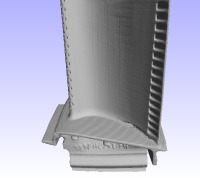
Turbine blade, 1.7 million polys.
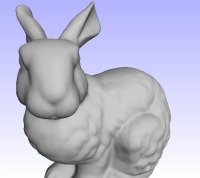
Stanford Bunny, 65k polys.
|
|
Clustered Backface Culling
Cluster Backface Culling is grouping a number of polygons together and evaluating culling them
as a group. How the faces are grouped together depends upon the implementation but the idea is to
save sending many of the polygons down to the graphics pipeline where they may be backface culled
as individuals. Why send a million polygons down to the pipeline to just have them rejected because
they are backface? By using some application level logic and data structures, we can eliminate
approximately 25% of the polygons!
Pseudo code for my implementation of the clustered backface culling algorithm:
Pre-processing
Sort polygons into groups.
For each group / cluster of polygons
Compute the Normal Cone for the cluster.
If the normal cone deviation is too great
Subdivide group based upon normal orientation
Run-time
For each group / cluster of polygons
if the group is completely backfacing (using the normal cone)
don't render.
if the group is culled by the view frustum
don't render.
Render the group.
The three main areas of technology in the above algorithm is the group sorting, the normal cone computation, and
culling using the normal cone. These will be discussed in further detail in the sections below.
|
Spatial Grouping
For this implementation, I chose to group faces by spatial locality. When loading the model into the
display structures, the polygons are sorted using a regular grid of cells. The sample application allows
changing the size of this cell grid, but in general one grid size has worked well for most models. The polygons are
sorted into one cell only.
The images to the right show a display where each cell is colored to illustrate where they begin and
end. Any curved boundaries between cells is due to the fact that the spatial division grid is a regular grid
and the turbine blade is a curved surface.
Normal Cone Computation
When the load into the display structures is complete, we are left with a grid of cells that contain an
unorganized collection of polygons. For each cell, a normal cone is computed. A normal cone is the average
normal of all the polygons in the cell, and the maximum deviation any normal in the cell has from that average
normal. This tells us in what direction the cell's polygons generally face. Now wait a minute, you say! If
the cell is an unorganized collection of polygons, they can face every direction! Given that we are discussing
models which are intended to have real life representations, we generally will not have this situation in a cell.
But, we have to handle this situation because a cell could have opposing surfaces, or contain a hole that is drilled
through an object. When the normal cone is computed, if the maximum deviation is too great, the cell simply subdivides
itself re-sorting based upon normal orientation. This is an extremely quick process, leaving us with a set of cells where
the normal cone orientation is meaningful.
To the right is an image which illustrates the cell subdivision handling. The turbine blade has holes drilled along
the ends of the blade. The cells which contain these holes would have had normal cones which would not have had much
use, so the cell subdivided. The subdivision is illustrated by the fact that the holes have different colored patches
inside them, even though the holes are obviously much smaller than the grid cell size.
To cull using the normal cone is similar normal backface culling. Instead of simply testing the dot product between the
view vector and normal for negative values, we need to consider how large angle is between the normal and the view vector
with respect to the maximum deviation in the normal cone. To reject the cluster, the average normal deviated toward the
view vector by the maximum deviation must still be backfacing.
View Frustum Culling
More polygons could be consistently rejected if the polygons were grouped by their normal orientation instead of
spatial locality. The reason for using spatial locality in grouping is that it allows us to perform view frustum
culling on the clusters. The bounding box (actually just the extents) of each cell are tested against the view frustum
to quickly determine whether the cell is potentially visible.
In the close up images to the right, 31% of the model has been culled by view frustum alone!
If the application domain involves close up views of models, this is definitely a big savings. If the model is more
often view as a whole, then grouping by normal orientation may provide more savings.
|
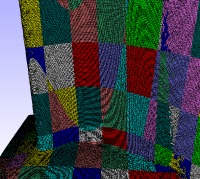
Turbine colored cell view.
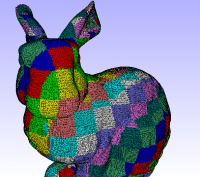
Bunny colored cell view.
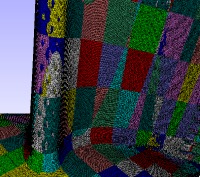
Colored cell view showing cells subdivided due to holes.
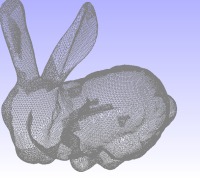
Wire-frame view of the bunny where cell rejection is more obvious.
|
Stats
So how effective is this? For the turbine blade model, between 21-23% of the model is always rejected by the clustered
backface algorithm alone. This is about 400k polygons which we never visit or issue to the graphics pipe. For the
Stanford Bunny, around 35% is rejected by the clustered backface algorithm.
When you combine the clustered backface culling with the view frustum culling, on the close up images of the turbine 54%
of the model has been culled! This amounts to 950K polygons culled!
|